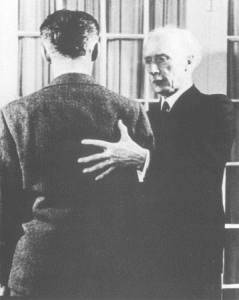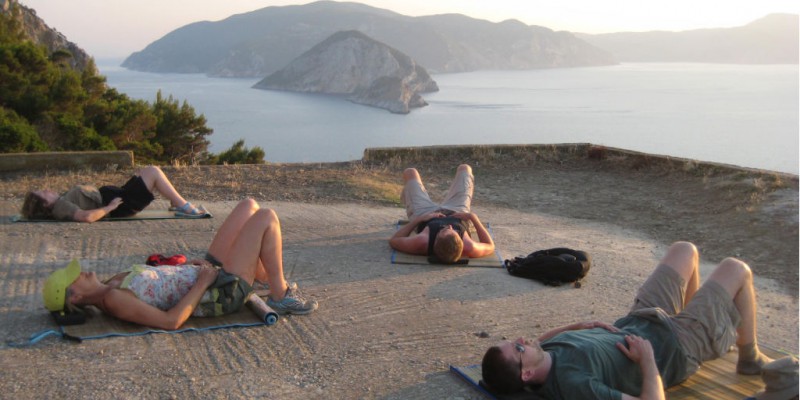One of the main philosophies behind the Alexander Technique is that the mind and body are intimately connected, working as one, and are influencing each other constantly. I tend to believe this claim. According to the theory we can, by becoming more aware of our body, improve our bad habits and postures, feel less tension in our mind, and work to prevent and alleviate pain all over our body. Over time our habits and bodily misuses can result in problems, and it is the job of the Alexander Technique to fix these problems.
What Is The Alexander Technique?
The Alexander Technique is an empowering teaching which aims to give the practitioner the awareness they need to make changes which improve posture, movement, balance, and natural alignment. This bodily awareness, according to the theory, allows us to function optimally both physically and mentally. As we all have different habits, the Alexander Technique is not a set system, or an exercise, or a therapy; it is an awareness which can be applied to and by each person. It is the job of the teacher to facilitate this awareness in the individual.
The Alexander Technique was born from the work of a Shakespearean orator, Frederick Matthias Alexander, who developed voice loss during his performances. Worried about his future, and with doctors unable to give a physical diagnosis, Alexander began a process of self examination. Looking at himself in several mirrors he began to

identify bad habits, such as resting his head incorrectly down and backwards on his spine, which were disrupting the flow of his breathing and vocal mechanism. Through his awareness and self work he cured his recurrent voice loss. He then began noting the bad habits of other individuals, realizing the wider context of his findings. He wrote several books, refined his techniques, and passed the Alexander Technique on by training new teachers.
Alexander Technique In Practice
The format of an Alexander Technique session usually consists of a one-on-one student to teacher environment, where the teacher observes the behavior, bodily habits and everyday postures of the student, and then offers individual advice based on the time they share together. They may show the student less strained ways to sit, stand, and move. Teachers sometimes use their hands to feel for tension, and sometimes show the student the image of their posture in a mirror, so that they can see for themselves how distorted and uncomfortable it looks!
There are some specific techniques that can be integrated into the session by the teacher. The “balanced resting state” for example encourages the practitioner to lie on their back, with their knees bent and feet on the floor. The posture allows weight and balance to be evenly distributed, and the body finds its resting point. The student scans the body for tension with their mind, from head to toe, with the assistance of a teacher or a voice recording.
Different teachers may use various combinations to relax and encourage bodily awareness in the student, but for the most part the technique is very much based on the teacher giving individual guidance. Most importantly, the teacher should aim to transfer the Alexander Technique as a piece of knowledge, which once understood, can be used by the practitioner with no further guidance. This can take several sessions, sometimes many, but ultimately the aim is not to keep the student hooked on the guidance; it is to liberate them through the knowledge, which they can use themselves without a teacher later on.
Every-Body Has Bad Habits
I had not heard of the Alexander technique until I lived with a trained and experienced teacher last year. Before I realized what her speciality involved, I had already taken due note of her near perfect posture, which was nothing short of divine. The alignment of her body left me something to desire when I compared it to my curled over slump. She looked at complete ease, like her body was at rest when she sat, stood, even moved. When she explained her profession it all made sense, and it was immediately obvious that she had applied what she was teaching; and that it had worked for her!
For one hour she gave us an intimate education of the Alexander technique, which was an eye-opening lesson to say the least. Several times habits and tensions in my posture were pointed out; habits which I had not been aware of until that moment when she had made me aware. My first lesson, and apparently this is true of many people, is that I rest my head (which I was told weighs something like 5kg) backwards on the top of my spine.
Try it now! Feel the weight of your head and see if you have the same habit of tilting it heavily backwards onto your delicate spine. Do you do it? The head, when it is balanced on its natural resting point, should be forward and up, not slumped down backwards on the spine. Consider the possibility that resting a massive 5kg head unnaturally on a delicate spinal chord could culminate in some damage one day!
There were some other habits that my teacher managed to get round to identifying; I always sit with one leg crossed over the other, but never the opposite way around, for example. Once identified, the teacher asked me if I could relate this to any pain that I may experience in my leg. Coincidentally, I could, and I am now aware of this pain in the moment it happens; every time I sit with my leg crossed in this manner.
I also have a habit of walking and standing with one foot pointing significantly outwards, where the other points forwards. This has caused me more than a little strain on my right knee, the one which I bend outwards. When I walk for long distances the bad habit takes its toll, and my knee begins to twist and cause me distress.
It is incredible that we are not even aware of our own postures. I do not know how many years these habits have been forming, nor for how long I have been unconsciously displaying them. Since the session, even though it was only one hour long, I can happily say that my posture is forever improving, and that I am becoming more and more aware of my body.
Let The Body Rest Naturally
From what I understood of the session, and of the conversations we had over dinner concerning the Alexander Technique, it is not considered an exercise, or something that is done, or something to try to improve; it is a teaching. This teaching, once passed on, and practiced over the course of many sessions (I only had one so I am technically no expert!), culminates in an increased awareness of our own postures and bodily habits. This awareness itself is enough for us to change these habits, or at least to have the choice to change them.

The whole premise is based on the idea that the body has a natural resting point. Like a spring, it is possible through our tensions and contractions, to stretch our body outwards or to crunch it inwards. Our bad habits are like the unnatural tensions in a forced spring, and when we release them through our awareness we are able to return to our natural resting point.
The Alexander Technique teachings assure us that our habits only feel right because we are used to them, and that in order to change the way we move, we must change the way we think. The overall result of our awareness and application of the teaching is that over time we will begin to reclaim our physical intelligence; that is, we will be able to move efficiently and with ease, and our posture and movement will speak as a creative expression of ourselves. This, according to the Alexander Technique, becomes a process of “leaving yourself alone,” and allowing the body to be natural.
Alleviating Pain, Back Problems, Parkinson’s And More
I am a young man who is fortunate enough to be able to say that I do not yet experience any major problems with my body. I still think it is incredibly useful to become aware of my own habits, and now I will hopefully be able to apply the teaching, and the resulting awareness, before any damage has been done.
Many people use the Alexander Technique in order to ease pain, post injury or illness. The Alexander Technique is beginning to accumulate a body of research to demonstrate its effectiveness. In one particularly compelling study, funded by the NHS, the Alexander Technique was shown to be beneficial for relieving long term back pain. Preliminary evidence has also suggested its role in improving respiratory functioning, stuttering, and general long term pain, although further research is needed in this area in order to prove the extent of its effectiveness.
The potential benefits for sufferers of Parkinson’s is also astounding, and the National Institute for Health and Care Excellence recommends the technique as a way of improving the physical and mental life for people who suffer from the disease, by reducing depression, boosting confidence, helping the person perform everyday tasks more effectively, and even slowing down symptoms.
Although the Alexander Technique is mostly a private treatment, some NHS trusts offer it to patients as part of outpatient care clinics. The teaching, backed by the positive research it has seen in recent years, is perhaps beginning to gain momentum as a respected mainstream treatment.
Final Thoughts…
It is recommended to attend several sessions practicing the Alexander Technique with a qualified teacher in order to fully gauge and understand the teaching and how to apply it. Singers, dancers, athletes and performers of all kinds use the technique to improve stamina and respiratory functioning, and healthy individuals can also benefit from this sort of bodywork. Long term pain is often rooted in strained posture and unconscious bodily habits. Anyone who is suffering who is looking for a safe, effective, and well researched alternative treatment, the Alexander Technique can provide.
I think we can all benefit from increasing our awareness of bodily habits and postures, and so I find the teaching to be universal. The Alexander Technique is a process of allowing ourselves to return to a natural posture, with each part of the body resting comfortably in balance. We are alive in a body that can function perfectly well. All we must do is unlearn our bad habits.

